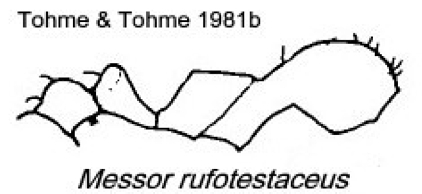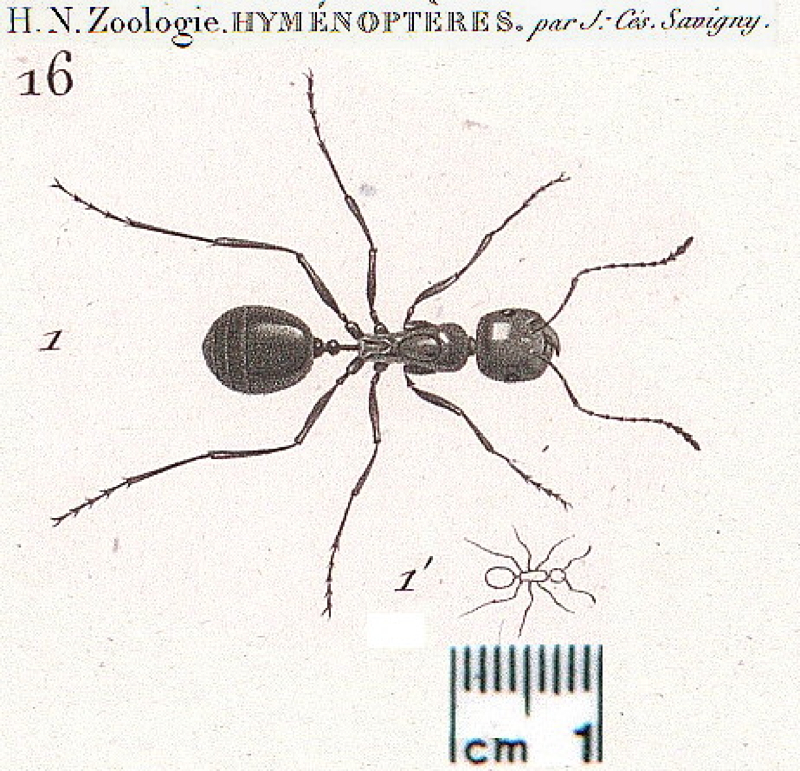Messor rufotestaceus (Foerster)
 Type location Algeria
(Formica rufotestacea, Foerster, 1850b: 489, worker; Messor
rufotestaceus Foerst., Emery, 1908e: 439, illustrated full
description, major & minor workers & queen; Forel, 1910a: male)
- no type images on
Antweb (March 2019) Type location Algeria
(Formica rufotestacea, Foerster, 1850b: 489, worker; Messor
rufotestaceus Foerst., Emery, 1908e: 439, illustrated full
description, major & minor workers & queen; Forel, 1910a: male)
- no type images on
Antweb (March 2019)
junior synonyms
thoracica
(Atta thoracica n. sp. Mayr,
1862: 742, illustrated, worker) from Syria - no images on
Antweb (March 2019)
gracilinodis
(Aphaenogaster gracilinodis n.
sp., Emery, 1878b: 55, worker) from Syria - no images on Antweb
(March 2019)
Perhaps not a Messor
at all but as Emery (1875) had, an Aphaenogaster.
|
  Foerster's (1850b)
description is at Foerster's (1850b)
description is at  .
Emery (1908e)
gave an illustrated (antenna) full
description,
this is at .
Emery (1908e)
gave an illustrated (antenna) full
description,
this is at  .
Mayr's (1862)
gave a description of thoracicus
is at .
Mayr's (1862)
gave a description of thoracicus
is at  . Emery's (1878b) description of gracilinodis
is at . Emery's (1878b) description of gracilinodis
is at  . Mohamed et al (2001) noted the
underside of the head has only moderately curved and straight hairs. . Mohamed et al (2001) noted the
underside of the head has only moderately curved and straight hairs.
Mayr's thoracicus
illustration shows short sharp propodeal teeth; Emery (1908e) wrote of
"stumpfen zahnen" = blunt teeth. Thome & Thome (1981b) showed
merely angles at the dorsum and declivity junction.
Cagniant (1996a) in his key leads to two species
which are essentially yellow-orange, have slender antennae and smooth
gasters. One, Aphaenogaster foreli
has propodeal spines, the other, which he gave as A. leveillei has no spines.
He noted the latter also as being synonymous with A. pallida laurenti of Santschi
(1939d: 69). Significantly both were
described from Algeria
and appear to match Foerster's description. The Syria locations were
added by Emery (1908) who also gave the dimorphism, something that
Cagniant appears not to have seen in North African specimens.
Note: The
difference and geographical distance between the Algeria type and the
Syria-Iran forms suggests that two distinct species may be
involved. In the absence of type images it is impossible to
resolve.
|
  Egypt
records - Wheeler & Mann (1916: 170) ; illustration in Tohmé
& Tohmé (1981b); Wadi Gharandel, Sinai; - record in Mohamed et
al (2001, illustrated). Sharaf list - material examined:
El-Qosseima (North Sinai), 14.iii.1997 (4) M.R.Sharaf; Wadi Digla
(Cairo), 13.iii.1955 (2); Wadi Digla (Cairo), 13.iii.1955 (1); Wadi
Digla (Cairo), 13.iii.1955 (2); Wadi El-Arbaein, St. Catherine (South
Sinai), 19.ii.1999 (1) M.R.Sharaf; Wadi Digla (Cairo), 13.iii.1955 (1)
(ASUC). Egypt
records - Wheeler & Mann (1916: 170) ; illustration in Tohmé
& Tohmé (1981b); Wadi Gharandel, Sinai; - record in Mohamed et
al (2001, illustrated). Sharaf list - material examined:
El-Qosseima (North Sinai), 14.iii.1997 (4) M.R.Sharaf; Wadi Digla
(Cairo), 13.iii.1955 (2); Wadi Digla (Cairo), 13.iii.1955 (1); Wadi
Digla (Cairo), 13.iii.1955 (2); Wadi El-Arbaein, St. Catherine (South
Sinai), 19.ii.1999 (1) M.R.Sharaf; Wadi Digla (Cairo), 13.iii.1955 (1)
(ASUC).
|
 From Egypt, what
appears to be rufotestaceus was
illustrated by Savigny (Audouin, J.-V. 1825-27: Plate 20 Fig 16). From Egypt, what
appears to be rufotestaceus was
illustrated by Savigny (Audouin, J.-V. 1825-27: Plate 20 Fig 16).
|
 The
photomontage is of a major worker from Iran, Roshanak Torabi (36). The
photomontage is of a major worker from Iran, Roshanak Torabi (36).
|
 The
photomontage is of a minor worker from Iran, RoshanakTorabi (36). The
photomontage is of a minor worker from Iran, RoshanakTorabi (36).
|
|